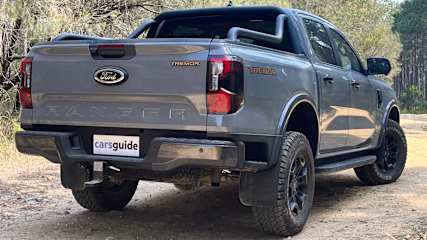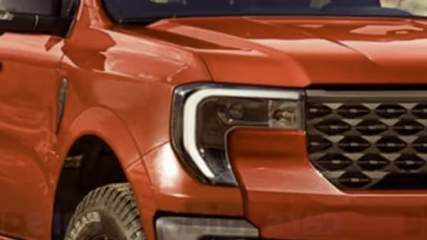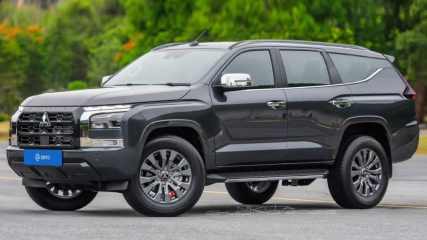1988 Mitsubishi Starwagon Reviews
You'll find all our 1988 Mitsubishi Starwagon reviews right here. 1988 Mitsubishi Starwagon prices range from $1,980 for the Starwagon Gl to $4,070 for the Starwagon Eci 4x4.
Our reviews offer detailed analysis of the 's features, design, practicality, fuel consumption, engine and transmission, safety, ownership and what it's like to drive.
The most recent reviews sit up the top of the page, but if you're looking for an older model year or shopping for a used car, scroll down to find Mitsubishi dating back as far as 1986.
Or, if you just want to read the latest news about the Mitsubishi Starwagon, you'll find it all here.
Mitsubishi Reviews and News
.jpg)
2025 Mitsubishi Triton range expands: 4x4 manual version headlines new cab-chassis variants as Japanese stalwart takes the fight to the Ford Ranger, Isuzu D-Max and Mazda BT-50
Read the article
By Tom White · 17 Mar 2025
Mitsubishi's Triton range will expand to once again include work-ready Cab Chassis models, including a manual 4x4!
.jpg)
New Mitsubishi Pajero takes shape: Big beefy 4WD to make a comeback to battle the Nissan Patrol and Toyota LandCruiser
Read the article
By Dom Tripolone · 14 Mar 2025
An old 4WD rivalry is about to be re-ignited. Mitsubishi is preparing a new off-road focused four-wheel drive, which is likely to be a replacement for the discontinued Pajero.

Is Australia's love affair with utes over? Sales of Toyota HiLux, Ford Ranger, Isuzu D-Max, Nissan Navara and Mitsubishi Triton plummet. And how did Toyota know? | Analysis
Read the article
By Laura Berry · 10 Mar 2025
Utes have been up there with the most popular vehicles bought by Australians for years, but sales have dropped significantly in 2025 signalling a huge change in buyer behaviour.
.jpg)
Mitsubishi Triton 2025 review: GLX-R - off-road test
Read the article
By Marcus Craft · 09 Mar 2025
The new-generation Mitsubishi Triton range marks the biggest change for the model in a long time: a new bi-turbo engine (150kW/470Nm), new chassis and suspension, overhauled design (with a longer wheelbase), and increased towing capacity, among a raft of changes.The new mid-grade GLX-R sports a few extras beyond what the lower-spec vehicles get - most importantly, Super Select 4WD-II.

7 ways Ford can improve the Ranger ute: 2026 Ford Ranger ute needs these fixes to fight off BYD Shark 6, Kia Tasman, Toyota HiLux, Isuzu D-Max and Mitsubishi Triton
Read the article
By Byron Mathioudakis · 09 Mar 2025
Here are the changes that we would like to see on the 2026 Ford Ranger facelift.
.jpg)
Resale heroes! The mid-sized SUVs that hold their value best. Exclusive report reveals the winners and losers from Toyota RAV4, Mitsubishi Outlander and Subaru Forester to the Kia Sportage, Mazda Cx-5 and Haval H6 | Analysis
Read the article
By Laura Berry · 08 Mar 2025
CarsGuide’s data analytics team has crunched the numbers to find out how well popular mid-sized SUVs hold their value. This insight means you can buy a new car now knowing it’ll likely be a resale winner when the time comes to sell it.

Move over diesel 4WDs, it's hybrid time: Why petrol-electric power found in the BYD Shark 6, Ford Ranger PHEV and coming Denza B5 will replace the diesel grunt in the Toyota LandCruiser, Mitsubishi Triton and Nissan Patrol | Opinion
Read the article
By Marcus Craft · 06 Mar 2025
With hybrid SUVs, such as the Mitsubishi Outlander PHEV, and utes, such as the BYD Shark 6, already here, and with more petrol-electric-powered vehicles on the way, like the BYD Fang Cheng Bao 5 (aka Denza B5, recently spotted testing in Australia), are petrol-electric hybrids set to relegate traditional ICE 4WDs into the dusty annals of history?Read on.A plug-in hybrid 4WD — one in which the electric motor runs the show until its battery is depleted enough that the internal-combustion engine kicks in as back-up — offers an effective compromise between helping to reduce the volume of climate change-induced woes our planet is being forced to suffer and still being able to get to and from your favourite campsite.Sure, it’s an all-wheel drive and best suited to light-duty off-roading, but the Mitsubishi Outlander PHEV is a great example of a well-executed hybrid that is already here and well worth a look.This mid-size SUV has a 2.4-litre four-cylinder petrol engine (producing 98kW at 5000rpm and 195Nm at 4300rpm), an electric motor on the front and rear axles, and a lithium-ion battery pack with a total capacity of 20kWh. Combined output (engine and electric motors) is 185kW and 450Nm and this PHEV’s electric-only driving range is listed as 84km on a full charge.It has a single-speed transmission and drive modes in this vehicle include Eco, Normal, Power, Tarmac, Gravel, Snow and Mud.This Outlander has three power-use modes: EV Mode (“perfect for low to medium speeds in urban areas”, according to Mitsubishi), Series Hybrid Mode (“when accelerating or climbing hills, the hybrid petrol engine can be used to generate additional power while the vehicle runs on motor power”), and Parallel Hybrid Mode (“for high-speed driving such as overtaking vehicles on the highway, the vehicle runs on engine power while being assisted by the electric motor”).The PHEV’s EV-only driving range is a listed 84km but my most recent test vehicle (a GSR-spec Outlander) used most of its battery power on a 110km highway trip. Regenerative braking regained very little of that used power and the Outlander switched to rely on petrol for the remaining 30km or so of that trip.It has a single-speed transmission and drive modes include Eco, Normal, Power, Tarmac, Gravel, Snow and Mud, which all tweak engine, electric motor, and transmission to suit the selected mode.This Outlander is pleasant on sealed surfaces And it’s comfortable and capable off-road as well — as long as you stick within the parameters of the kind of “off-road” terrain an AWD SUV is built to cope with: well-maintained gravel roads and dirt tracks with minor corrugations in dry conditions or, at worst, rain-puddled blacktop.The Outlander has off-road measures that are fine for a city-focussed vehicle: 18.3 (degrees approach angle), 22.2 degrees (departure), 18 degrees (ramp breakover), and 203mm of ground clearance (unladen).It’s nimble in the bush (because steering is sharp), visibility is satisfactory all-round, and it settles well on gravel and dirt tracks at speed, only skipping around on rougher sections, due to its firm suspension and road tyres.You can switch drives modes to Gravel, Snow or Mud to best suit the terrain, however, the Outlander’s lack of ground clearance, road-biased tyres and 20-inch wheels, impact its capability.But, this is still a handy dirt-road tourer, yielding comfortable and controlled ride and handling, as well as an overall refined driving experience, only ever becoming rattled when the road or track surface becomes very chopped up and bumpy.The Outlander’s Super-All Wheel Control (S-AWC) system deserves a fair amount of credit. This electric-powered traction control system manages torque application so it is instantaneous, he system cuts power to the wheel that has little grip and sends drive to the wheel with the most grip, and delivers that drive with impressive levels of throttle control and an even-handed management of power.Payload is listed as 605kg, towing capacity is 750kg (unbraked) and 1600kg (braked). GVM is 2750kg and GCM is 4350kg.My most recently tested example, the Mitsubishi Outlander GSR PHEV, has a listed fuel consumption of 1.5L/100km on a combined cycle but, as with all official fuel figures from any carmaker, you can take it with a grain of salt.On my most recent test, dash-indicated fuel consumption was 5.8L/100km; actual fuel consumption, as measured from pump to pump, was 7.7L/100km.Dash-indicated power usage was 20.8kWh/100km. This PHEV gobbled through most of its 20kWh battery capacity quite swiftly on the drive from the vehicle pick-up point in Sydney to our test start-point just over 100km away. It recouped 10km electric driving range via regenerative braking on a series of long downhills when set to ‘Charge’ driving mode (with the combustion engine generating power to the battery), but I had to cycle through regen modes to optimise that power regain.The dash-indicated combined driving range (battery and engine) was 748km on a full charge and a full 56-litre tank.Note: off-roading places a heavier burden on any vehicle – combustion, hybrid, EV – so battery capacity in a PHEV will be depleted faster and more fuel will be used than on sealed surfaces.Another intriguing hybrid already here is the BYD Shark 6 ute. This first for Australia – a plug-in hybrid ute – presents a strong case, in terms of performance and potential.It has a 1.5-litre four-cylinder turbo petrol engine with dual electric motors: a 170kW/310Nm front motor and a 150kw/340Nm rear motor (total: 320kW and 650Nm).This BYD ute has a claimed driving range of 100km (electric only), and approximately 850km (hybrid).That’s a decent stretch of driving and worth noting because a plug-in hybrid doesn’t burden its driver with the crippling range anxiety that troubles some EV drivers.The Shark has a listed payload of 850kg and braked towing capacity of 2500kg. It doesn’t have the 1000kg payload or 3500kg market-standard towing capacity of non-hybrid utes, but it can still take on a considerable burden and clock up big distances before it needs to be refuelled/recharged, which is more than anyone can reasonably expect from any current EV.The good news is there are more hybrid 4WDs to come that, on paper at least, also have the potential to be decent off-roaders.Most noteworthy for now is the Shark 6’s stablemate, the Denza B5. As a a plug-in hybrid 4WD with a ladder-frame chassis and BYD’s Dual-Motor Intelligence technology onboard, the Denza B5 has a similar powertrain and platform set-up to the Shark 6.The B5 has a 1.5-litre four-cylinder petrol engine with twin electric motors (one at each axle) producing a very impressive 500kW and 760Nm.Bolstering its expected capability off-road, the B5 has that aforementioned ladder-frame chassis, three diff locks, 18-inch BFGoodrich all-terrain tyres and the brand's Intelligent Hydraulic Body Control System. Similar in principle to other existing systems in other vehicles – for example, onboard the Nissan Patrol – this set-up is claimed to tighten on-road for more dynamic on-road driving and loosen off-road for more wheel articulation – but it is also claimed to be able to independently raise wheel heights by up to 200mm.In other good news for those who want plenty of driving range out of their touring 4WD, the B5 has a 31.4kWh battery – bigger than that of a standard hybrid – and that’s tipped to yield a 120km electric driving range. All up though – with a full fuel tank and fully charged battery – this Chinese-made 4WD should offer a total driving range of more than 1000km.So, it’s obvious the 4WD realm is rapidly changing and the future is a world in which there are more well-engineered and off-road-capable PHEVs on the road and on bush tracks.
.jpg)
Goodbye Mitsubishi Eclipse Cross, hello Grandis? 2025 Mitsubishi Grandis to debut in Europe as hybrid rival to Nissan Qashqai, Kia Seltos, and Haval Jolion
Read the article
By Tom White · 24 Feb 2025
Mitsubishi has revealed its next new small SUV model, the Grandis, which will sit above the ASX but below the Outlander in its international line-up, offering both mild and full hybrid drivetrain options.

Mitsubishi's tough new 4WD takes shape: Mitsubishi Pajero Sport likely to return with petrol-electric plug-in hybrid power to batter the Ford Everest and Toyota Prado
Read the article
By Dom Tripolone · 23 Feb 2025
Mitsubishi’s rugged Pajero Sport four-wheel drive is no more, but help is on the way.
.jpg)
Nissan Honda merger off: why it's the best news this year (so far) | Opinion
Read the article
By Byron Mathioudakis · 23 Feb 2025
Honda and Nissan simply should not merge. When it was announced that the Memorandum of Understanding (MOU) signed last December “for consideration of a business integration between the two companies” was terminated on February 13, many people would have breathed a sigh of relief.




